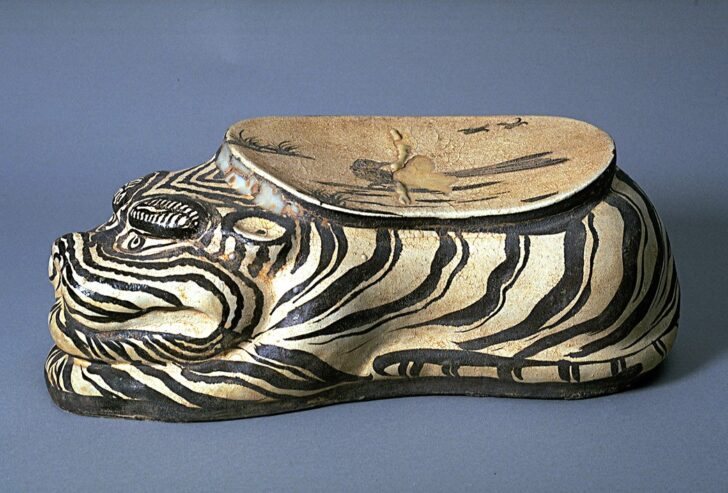Pillow
Chinese

Description
Throughout East Asia, pillows are often made of hard materials, because they are actually neck rests, designed to protect elaborately lacquered coiffures by holding the head above the surface of bed. Chinese potters often produced delightfully whimsical designs for these pillows, such as this crouching tiger. Sweet dreams!
Maribeth Graybill, Senior Curator of Asian Art
Exhibited in "Flora and Fauna in Chinese Art," April 6, 2002 - December 1, 2002.
Subject Matter:
This is a cizhou (磁州) tiger-shaped pillow of the Jin dynasty (1115-1234). Kilns in Henan and Shanxi specialized in making this type of pillow. Throughout East Asia, pillows are often made of hard materials because they are actually neck rests, designed to protect elaborately lacquered coiffures by holding the head above the surface of bed. Chinese potters often produced delightfully whimsical designs for these pillows, such as this crouching tiger.
Tigers in China are associated with courage, bravery, and strength. Besides being one of the animals of the zodiac, a white tiger is one of the spiritual animals of the four directions representing the West. The magpie, a bird depicted on the pillow, is associated with being bearers of good news. Since the Jin dynasty was formed by the Northern nomadic Jurchen tribe, it may be relevant to note that in Korean culture there are countless images of tigers with magpies, due to a popular folk tale about a magpie who convinces a tiger to save the life of a man: thus magpies are seen as protective creatures.
Cizhou 磁州 ware has well known since the Song dynasty with production lasting through the Qing, but it reached its zenith during the Jin and Yuan dynasties, where the forms were especially robust and decoration finely executed. The ware is characterized by its high contrast dark brown to black and white wares, although over a dozen types of decoration can be used. These techniques include painting, sgraffito, incision, overglaze, underglaze, along with the application of multi-colored glazes. The variety of sub-styles is a result from being produced at a variety of Northern kilns in Hebei, Henan, Shandong, and Shanxi. These everyday, if not somewhat plebian wares consisted primarily of large jars, vases, pillows, and bowls.
Physical Description:
This is a smooth stoneware piece in the form of a crouching tiger. It has a concave platform on its back and is covered in white slip with black calligraphic stripes. The platform is painted with a bird among grasses.
Usage Rights:
If you are interested in using an image for a publication, please visit https://umma.umich.edu/request-image/ for more information and to fill out the online Image Rights and Reproductions Request Form.